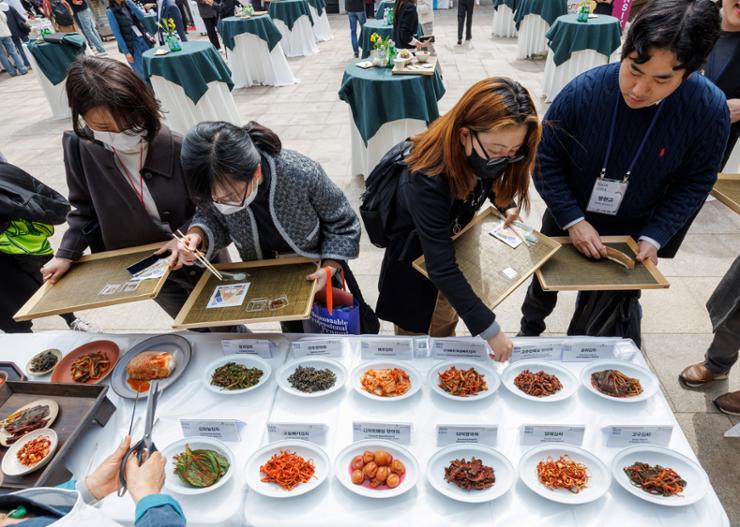
Chef Son Jong-won speaks during "Taste of Hansik, Taste of Korea," an event organized by the Ministry of Agriculture, Food and Rural Affairs, and the Korean Food Promotion Institute, in time for 2025 Asia's 50 Best Restaurants event at the Korea House in central Seoul, Tuesday. Courtesy of Korean Food Promotion Institute
Star chef Son Jong-won, head chef of two Michelin one-starred restaurants Eatanic Garden and L'Amant Secret, noted Korea's abundance of distinctive ingredients from the country's unique geography of mountains and coastlines on three sides.
The Ministry of Agriculture, Food and Rural Affairs and the Korean Food Promotion Institute organized the "Taste of Hansik, Taste of Korea" event to promote Korean cuisine, in time for the 2025 Asia's 50 Best Restaurants event, which was held in the country on the day for the second time since last year.
During the event at Korea House in central Seoul, Tuesday, Son shared his insights on the evolution and expansion of Korean cuisine.
"When I first came to Korea (after working abroad), I was actually quite dissatisfied with the ingredients. Like, I would think, 'Where are the ingredients I used in the U.S.? There's no fresh asparagus here,' and I thought cooking here would be difficult. Then, I realized my perspective was quite narrow," he said.
"Korea is surrounded by seas on three sides for so many types of fresh seafood ingredients and also diverse vegetables, which are especially wonderful now in spring. If you just go to the market, you can see so many different types of 'namul' (wild greens) … In fact, by using these ingredients to create Western-style dishes, I believe this could also be part of the identity of Korean cuisine."

Chef prepare Korean dishes for participants during the "Taste of Hansik, Taste of Korea" event at Korea House in central Seoul, Tuesday. Yonhap
With Korean food gaining growing attention globally, there have been various representations of Korean cuisine around the world. The chef expressed that having a foundation built on tradition is most valuable to introduce the cuisine.
"Defining what Korean cuisine is has always been a very difficult question to answer. When someone asks if 'sinseollo' (traditional royal stew) or 'gujeolpan' (traditional assorted vegetable dish) represent Korean food, it's correct but we actually don't eat that in our daily lives … So in some ways, foods like spicy fried chicken have become widely representative foods of Korea," he said.
"I continue to ask myself this question and am still contemplating it. Foods like gimbap and dumplings are also part of Korean cuisine. So ultimately, I think the most important thing is understanding tradition … I believe that you can't create something new without fully understanding tradition."
When asked what food or ingredients from Korean cuisine will become the next global trend, he shared that perilla oil, commonly used in Korean cuisine, has great potential to grow in the global market.
"When you go to Italy, olive oil is one of the things that symbolizes Italy. But there aren't many countries that enjoy perilla oil. If you look at olive oil, the prices range from a few thousand won to hundreds of thousands of won. And there are a lot of high-quality ones too. But I feel that perilla seed oil is relatively undervalued," he said.

Participants try different types of kimchi during the "Taste of Hansik, Taste of Korea" event at Korea House in central Seoul, Tuesday. Yonhap
"Since I've worked abroad, I often look at things from the perspective of chefs working overseas. And I think these elements could be a key point of Korean cuisine. Even when making a salad, just adding olive oil gives it a distinct flavor, a slightly spicy and nutty aroma that feels really nice. And I think perilla oil offers a similar nuance."
Following the talk session, chefs, including participants from the hit cooking show "Culinary Class Wars," collaborated to offer a taste of Korean cuisine. Chef Cho Seo-hyeong of Euljiro Boseok introduced her signature assorted namul dish with tofu; chefs Kim Do-yun and Song Hong-yoon of Yunseoul and Myeonseoul prepared cold noodles; chef Oh Jun-tak of Chicken Cooking Club prepared roasted chicken topped with namul and bulgogi sauce; and chef Lee Jung-dae of JUNGDAE offered a bowl of locally sourced seafood including seaweed from Ulleung Island and Wan Island.
Chef Park Kwang-hee, who specializes in kimchi, introduced various kinds of kimchi made with organic ingredients from Gangwon Province, like "dureup" (aralia elata shoots) and dandelion.
 Subscribe
Subscribe E-Paper
E-Paper
